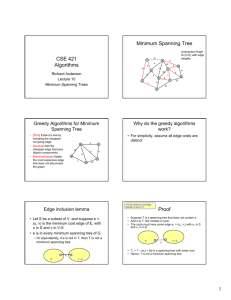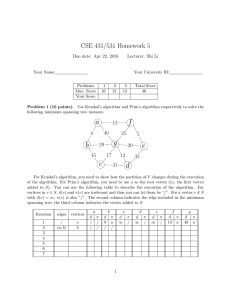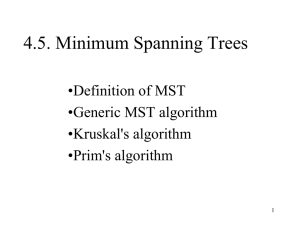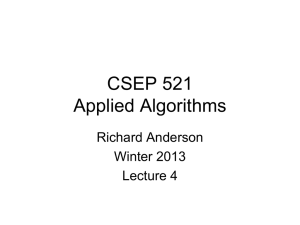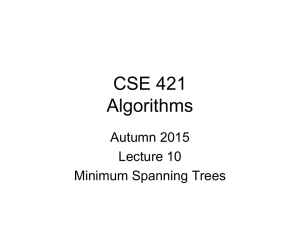4.5. Minimum Spanning Trees •Definition of MST •Generic MST algorithm •Kruskal's algorithm
advertisement
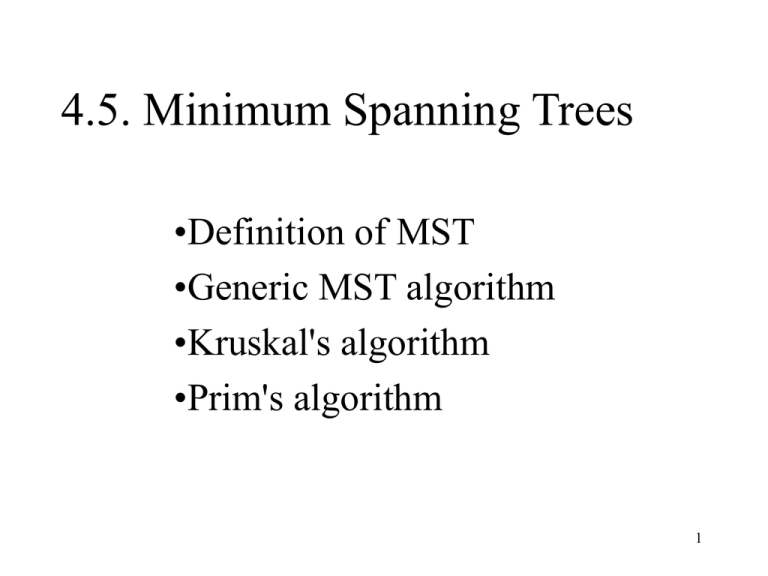
4.5. Minimum Spanning Trees
•Definition of MST
•Generic MST algorithm
•Kruskal's algorithm
•Prim's algorithm
1
Definition of MST
• Let G=(V,E) be a connected, undirected graph.
• For each edge (u,v) in E, we have a weight w(u,v) specifying
the cost (length of edge) to connect u and v.
• We wish to find a (acyclic) subset T of E that connects all of
the vertices in V and whose total weight is minimized.
• Since the total weight is minimized, the subset T must be
acyclic (no circuit).
• Thus, T is a tree. We call it a spanning tree.
• The problem of determining the tree T is called the
minimum-spanning-tree problem.
2
Application of MST: an example
• In the design of electronic circuitry, it is often
necessary to make a set of pins electrically
equivalent by wiring them together.
• To interconnect n pins, we can use n-1 wires, each
connecting two pins.
• We want to minimize the total length of the wires.
• Minimum Spanning Trees can be used to model
this problem.
3
Electronic Circuits:
4
Electronic Circuits:
5
Here is an example of a connected graph
and its minimum spanning tree:
8
4
c
b
i
7
8
d
2
11
a
7
4
6
h
14
e
10
g
1
9
f
2
Notice that the tree is not unique:
replacing (b,c) with (a,h) yields another spanning tree
with the same minimum weight.
6
Growing a MST(Generic Algorithm)
GENERIC_MST(G,w)
1
A:={}
2
while A does not form a spanning tree do
3
find an edge (u,v) that is safe for A
4
A:=A∪{(u,v)}
5
return A
• Set A is always a subset of some minimum spanning tree.
This property is called the invariant Property.
• An edge (u,v) is a safe edge for A if adding the edge to A
does not destroy the invariant.
• A safe edge is just the CORRECT edge to choose to add to
T.
7
How to find a safe edge
We need some definitions and a theorem.
• A cut (S,V-S) of an undirected graph G=(V,E) is a
partition of V.
• An edge crosses the cut (S,V-S) if one of its
endpoints is in S and the other is in V-S.
• An edge is a light edge crossing a cut if its weight
is the minimum of any edge crossing the cut.
8
8
4
S↑ a
c
b
i
7
V-S↓
d
2
11
8
7
4
6
h
14
e
↑S
10
g
1
9
f
2
↓ V-S
• This figure shows a cut (S,V-S) of the graph.
• The edge (d,c) is the unique light edge
crossing the cut.
9
Theorem 1
• Let G=(V,E) be a connected, undirected graph with a realvalued weight function w defined on E.
• Let A be a subset of E that is included in some minimum
spanning tree for G.
• Let (S,V-S) be any cut of G such that for any edge (u, v) in
A, {u, v} S or {u, v} (V-S).
• Let (u,v) be a light edge crossing (S,V-S).
• Then, edge (u,v) is safe for A.
• Proof: Let Topt be a minimum spanning tree.(Blue)
•
•
•
•
•
A --a subset of Topt and (u,v)-- a light edge crossing (S, V-S)
If (u,v) is NOT safe, then (u,v) is not in T. (See the red edge in Figure)
There MUST be another edge (u’, v’) in Topt crossing (S, V-S).(Green)
We can replace (u’,v’) in Topt with (u, v) and get another treeT’opt
Since (u, v) is light (the shortest edge connect crossing (S, V-S), T’opt is
also optimal.
1
1
1
1
2
1
1
1
10
Corollary .2
• Let G=(V,E) be a connected, undirected graph with a realvalued weight function w defined on E.
• Let A be a subset of E that is included in some minimum
spanning tree for G.
• Let C be a connected component (tree) in the forest
GA=(V,A).
• Let (u,v) be a light edge (shortest among all edges
connecting C with others components) connecting C to
some other component in GA.
• Then, edge (u,v) is safe for A. (For Kruskal’s algorithm)
11
The algorithms of Kruskal and Prim
• The two algorithms are elaborations of the generic
algorithm.
• They each use a specific rule to determine a safe
edge in line 3 of GENERIC_MST.
• In Kruskal's algorithm,
– The set A is a forest.
– The safe edge added to A is always a least-weight edge
in the graph that connects two distinct components.
• In Prim's algorithm,
– The set A forms a single tree.
– The safe edge added to A is always a least-weight edge
connecting the tree to a vertex not in the tree.
12
Kruskal's algorithm(basic part)
1
2
3
3
(Sort the edges in an increasing order)
A:={}
while E is not empty do {
take an edge (u, v) that is shortest in E
and delete it from E
4
if u and v are in different components then
add (u, v) to A
}
Note: each time a shortest edge in E is considered.
13
Kruskal's algorithm (Fun Part, not required)
MST_KRUSKAL(G,w)
1 A:={}
2 for each vertex v in V[G]
3
do MAKE_SET(v)
4 sort the edges of E by nondecreasing weight w
5 for each edge (u,v) in E, in order by
nondecreasing weight
6
do if FIND_SET(u) != FIND_SET(v)
7
then A:=A∪{(u,v)}
8
UNION(u,v)
9 return A
(Disjoint set is discussed in Chapter 21, Page 498)
14
Disjoint-Set (Chapter 21, Page 498)
• Keep a collection of sets S1, S2, .., Sk,
– Each Si is a set, e,g, S1={v1, v2, v8}.
• Three operations
– Make-Set(x)-creates a new set whose only member is x.
– Union(x, y) –unites the sets that contain x and y, say, Sx
and Sy, into a new set that is the union of the two sets.
– Find-Set(x)-returns a pointer to the representative of the
set containing x.
– Each operation takes O(log n) time.
15
• Our implementation uses a disjoint-set data
structure to maintain several disjoint sets of
elements.
• Each set contains the vertices in a tree of the
current forest.
• The operation FIND_SET(u) returns a
representative element from the set that contains u.
• Thus, we can determine whether two vertices u
and v belong to the same tree by testing whether
FIND_SET(u) equals FIND_SET(v).
• The combining of trees is accomplished by the
UNION procedure.
• Running time O(|E| lg (|E|)). (The analysis is not required.)
16
The execution of Kruskal's algorithm (Moderate part)
•The edges are considered by the algorithm in sorted
order by weight.
•The edge under consideration at each step is shown
with a red weight number.
8
4
c
b
i
7
8
d
2
11
a
7
6
h
14
4
e
10
g
1
9
f
2
17
8
c
b
4
i
7
8
d
2
11
a
7
h
10
g
f
1
2
8
4
c
d
2
i
7
8
7
b
11
a
14
4
6
h
9
e
10
g
1
e
14
4
6
9
f
2
18
8
4
c
b
i
7
8
4
8
f
1
2
8
7
c
d
2
i
7
14
4
6
h
9
e
10
g
1
e
10
g
b
9
14
4
6
h
11
a
d
2
11
a
7
f
2
19
8
4
c
b
i
7
8
4
8
f
1
2
8
7
c
d
2
i
7
14
4
6
h
9
e
10
g
1
e
10
g
b
9
14
4
6
h
11
a
d
2
11
a
7
f
2
20
8
4
c
b
i
7
8
4
8
f
1
2
8
7
c
d
2
i
7
14
4
6
h
9
e
10
g
1
e
10
g
b
9
14
4
6
h
11
a
d
2
11
a
7
f
2
21
8
4
c
b
i
7
8
4
8
f
1
2
8
7
c
d
2
i
7
14
4
6
h
9
e
10
g
1
e
10
g
b
9
14
4
6
h
11
a
d
2
11
a
7
f
2
22
Prim's algorithm(basic part)
MST_PRIM(G,w,r)
1. A={}
2. S:={r} (r is an arbitrary node in V)
3. Q=V-{r};
4. while Q is not empty do {
5
take an edge (u, v) such that (1) u S and v Q (v S ) and
(u, v) is the shortest edge satisfying (1)
6
add (u, v) to A, add v to S and delete v from Q
}
23
Prim's algorithm
MST_PRIM(G,w,r)
1
for each u in Q do
2
key[u]:=∞
3
parent[u]:=NIL
4 key[r]:=0; parent[r]=NIL;
5
QV[Q]
6
while Q!={} do
7
u:=EXTRACT_MIN(Q); if parent[u]Nil print (u, parent[u])
8
for each v in Adj[u] do
9
if v in Q and w(u,v)<key[v]
10
then
parent[v]:=u
11
key[v]:=w(u,v)
24
• Grow the minimum spanning tree from the root
vertex r.
• Q is a priority queue, holding all vertices that are
not in the tree now.
• key[v] is the minimum weight of any edge
connecting v to a vertex in the tree.
• parent[v] names the parent of v in the tree.
• When the algorithm terminates, Q is empty; the
minimum spanning tree A for G is thus
A={(v,parent[v]):v∈V-{r}}.
• Running time: O(||E||lg |V|).
25
The execution of Prim's algorithm(moderate part)
8
the root
vertex
4
c
b
i
7
8
4
8
f
1
2
8
7
c
d
2
i
7
14
4
6
h
9
e
10
g
1
e
10
g
b
9
14
4
6
h
11
a
d
2
11
a
7
f
2
26
8
4
c
b
i
7
8
4
8
f
1
2
8
7
c
d
2
i
7
14
4
6
h
9
e
10
g
1
e
10
g
b
9
14
4
6
h
11
a
d
2
11
a
7
f
2
27
8
4
c
b
i
7
8
4
8
f
1
2
8
7
c
d
2
i
7
14
4
6
h
9
e
10
g
1
e
10
g
b
9
14
4
6
h
11
a
d
2
11
a
7
f
2
28
8
4
c
b
i
7
8
4
8
f
1
2
8
7
c
d
2
i
7
14
4
6
h
9
e
10
g
1
e
10
g
b
9
14
4
6
h
11
a
d
2
11
a
7
f
2
29
8
4
c
b
i
7
8
d
2
11
a
7
6
h
14
4
e
10
g
1
9
f
2
Bottleneck spanning tree: A spanning tree of G whose
largest edge weight is minimum over all spanning trees of G.
The value of the bottleneck spanning tree is the weight of the
maximum-weight edge in T.
Theorem:
A minimum spanning tree is also a bottleneck
spanning tree. (Challenge problem)
30
